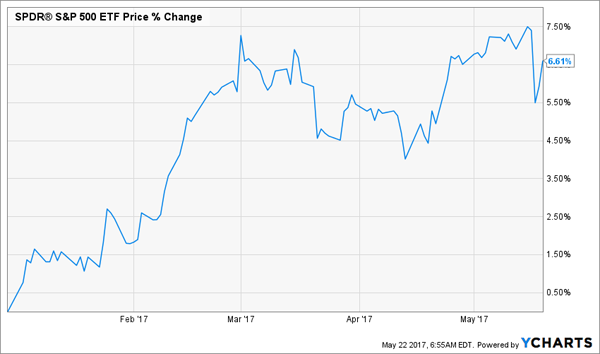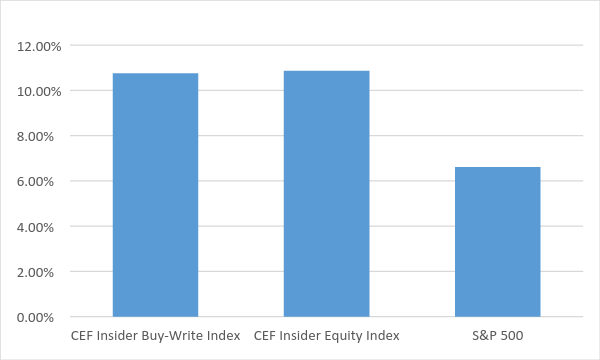Index investing is popular among investors for one reason: most people don’t want to put the time and effort into finding investments selling at deep discounts.
The most popular way to get into index investing is through exchange-traded funds, which have replaced mutual funds as the hot investment vehicle of the day.
There’s just one problem: even the highest-yielding ETFs are only paying 4% dividends. This doesn’t mean you can’t get bigger yields from index investing, however; it just means you have to look further afield. Today I’m going to show you a way to jump into index investing and get a 7.4% income stream at the same time.
The key lies in the indexes themselves. To differentiate their funds, ETF issuers have created new indexes that they believe will beat the market as a whole. The popularity of this investment approach means that there are now more indexes than actual stocks! The number of indexes has risen more than fivefold since 2012, while the number of actual stocks has fallen from 7,487 in 1995 to just over 4,300 today.
So do these new indexes actually outperform the S&P 500? Sometimes.
But to really win here, you have to do what our passive ETF buyers won’t: identify the index that is overbought and sell it, then find the oversold index and buy that. This often means rotating in and out of asset classes as a contrarian to take advantage of market panics and sell out of unsustainable short-term euphoria.
Closed-end funds offer us a particularly potent way to take advantage of radical disconnects between different indexes’ performances and, considering CEFs are absolutely crushing the S&P 500 this year, it seems that the market is waking up to this opportunity. One can rotate in and out of CEFs to capitalize on their wide price swings—the only problem is there aren’t any indexes that help investors identify which CEFs to buy and when.
That’s why, as I first mentioned in a May 23 article, my CEF Insider service is developing the CEF Insider Closed-End Fund Indexes, a collection of indexes that track which CEFs are beating the S&P 500. The amazing thing here is that, despite CEFs’ higher yields (these funds pay about 6.5%, on average, but some yield much more), CEF price gains are trouncing the S&P 500.
So far, the SPDR S&P 500 ETF (SPY) is up 6.6% for 2017:
Stocks Are Doing Well in 2017…

However, both the CEF Insider Equity Index (which tracks US stock funds) and the CEF Insider Buy-Write Index (which tracks funds that sell covered calls on mostly US stock holdings) are up 10.8% each over the same period—and that doesn’t account for reinvested dividends:
…But CEFs Are Doing Better

On top of the bigger price gains, equity CEFs (including the three I recommended in a May 1 article) pay dividends that are over three times bigger than those of the S&P 500, on average, meaning you’re getting a 7.4% income stream and beating the market on a price basis, too. And you’re still getting the same exposure to high-quality US stocks.
That doesn’t mean you should buy every CEF in these indexes, however. Returns from these funds range from 0% to 26%. In addition, NAV returns are far behind price returns for both indexes:
Prices Run Ahead of Underlying Value

To understand what this means, we need to think a bit about how closed-end-fund prices rise. Unlike with ETFs and mutual funds, whose price returns closely follow the value of the funds’ holdings themselves, closed-end funds can be priced much higher or lower than the funds’ actual net asset values. When investors favor CEFs generally, prices can go up much higher than the funds’ NAVs. When investors shun CEFs, prices can go down much lower than the funds’ actual NAVs.
This also means that funds can see their NAVs go up while their prices go down. This doesn’t happen for very long, but it is the holy grail of CEF investing: when a fund is killing it in the market but investors aren’t buying the fund, it creates a massive price inefficiency. You can simply jump in, buy the fund and wait for the market to realize its error.
That’s what’s happening to the CEF market as a whole. From 2014 to 2016, investors largely ignored these funds as the ETF universe exploded. That made the funds’ prices fall steeply, but a lot of CEFs saw their NAVs jump over the last couple of years. That’s created a massive price inefficiency that CEF investors are now benefiting from.
And finding the very best bargains in CEF land is easy.
In fact, I’ve done it for you—and put the names of 4 of the biggest bargains (with the highest yields—I’m talking 7.6% payouts on average here) into a NEW FREE report called, simply, “4 Great CEFs to Buy Now: 7.5% Yields and 20% Upside Ahead.”
I like to think of these funds as a “mini-index” all on their own: they come from all different corners of the CEF universe—real estate, bonds, equities and international securities—to hand you an extra level of safety on top of that fat 7.6% average yield!
Your copy is waiting for you now. All you have to do is go right here to get all the details on my profitable (and safe) CEF investing strategy and the names of these 4 stealth fund picks now.

Recent Comments